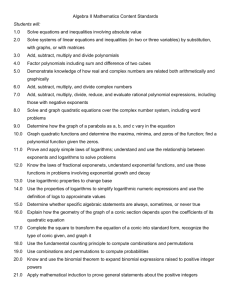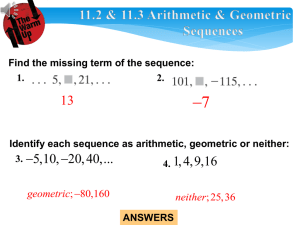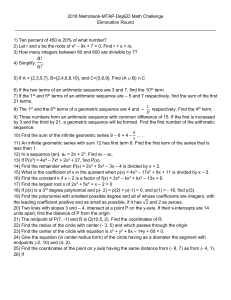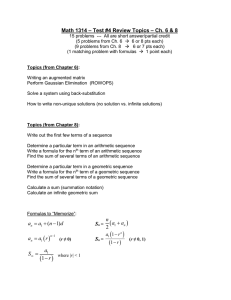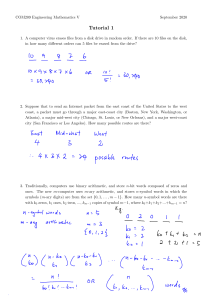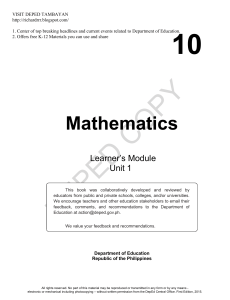COLLEGE ALGEBRA – Final Exam Review x f
advertisement
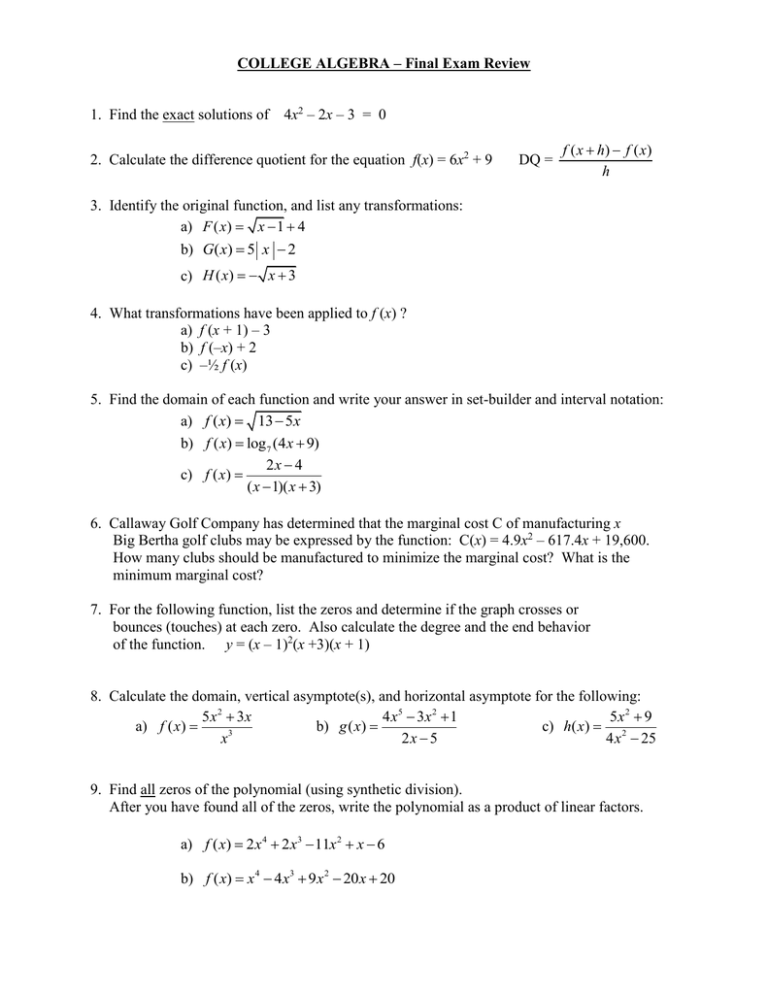
COLLEGE ALGEBRA – Final Exam Review 1. Find the exact solutions of 4x2 – 2x – 3 = 0 2. Calculate the difference quotient for the equation f(x) = 6x2 + 9 DQ = f ( x h) f ( x ) h 3. Identify the original function, and list any transformations: a) F ( x) x 1 4 b) G( x) 5 x 2 c) H ( x) x 3 4. What transformations have been applied to f (x) ? a) f (x + 1) – 3 b) f (–x) + 2 c) –½ f (x) 5. Find the domain of each function and write your answer in set-builder and interval notation: a) f ( x) 13 5x b) f ( x) log 7 (4 x 9) 2x 4 c) f ( x) ( x 1)( x 3) 6. Callaway Golf Company has determined that the marginal cost C of manufacturing x Big Bertha golf clubs may be expressed by the function: C(x) = 4.9x2 – 617.4x + 19,600. How many clubs should be manufactured to minimize the marginal cost? What is the minimum marginal cost? 7. For the following function, list the zeros and determine if the graph crosses or bounces (touches) at each zero. Also calculate the degree and the end behavior of the function. y = (x – 1)2(x +3)(x + 1) 8. Calculate the domain, vertical asymptote(s), and horizontal asymptote for the following: 5 x 2 3x 4 x5 3x 2 1 5x2 9 g ( x ) h ( x ) a) f ( x) b) c) x3 2x 5 4 x 2 25 9. Find all zeros of the polynomial (using synthetic division). After you have found all of the zeros, write the polynomial as a product of linear factors. a) f ( x) 2 x 4 2 x3 11x 2 x 6 b) f ( x) x 4 4 x3 9 x 2 20 x 20 10. If f(x) = 2 – x, and g(x) = 3x2 + 1, then calculate (f◦g)(x) 11. Calculate the inverse function of f ( x) 53 x 7 12. Convert to exponential form: log 6 x 17 13. Convert to logarithmic form: 45 1024 log 2 a 2 b 14. Write as a sum/difference of logs: 3log 2 a 4log 2 5 6log 2 2 15. Write as a single logarithm: 16. Solve for x: a) log3 x 2 5 b) 2e5 x 1 12 c) 32 x1 243 17. The growth rate of the world’s population in 2003 was 1.16%. The population of the world in 2003 was 6,302,486,693. Using the growth model A(t) = A0ekt, when will the world’s population reach 10,000,000,000 (ten billion)? 18. Solve each using Gaussian Elimination: x 2 y z 3 b) 2 x 4 y z 7 2 x 2 y 3z 4 2 x 4 y 2 a) 3 x 2 y 3 3, 7, 11, 15, … 19. Consider the following sequence: a) Is the sequence arithmetic, geometric, or neither? b) Find the 20th term of the sequence. c) Find the sum of the first 20 terms of the sequence. 1, 2, 4, 8, … 20. Consider the following sequence: a) Is the sequence arithmetic, geometric, or neither? b) Find the 20th term of the sequence. c) Find the sum of the first 20 terms of the sequence. 21. Calculate the sum: 1 a) 3 i 1 2 i 1 b) 6 3 i 1 i 1 You should “memorize” the following formulas: The Quadratic Formula Exponential Growth/Decay th n term of an Arithmetic Sequence Sum of n terms of an Arithmetic Sequence th n term of a Geometric Sequence Sum of n terms of a Geometric Sequence Sum of an Infinite Sequence

